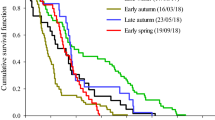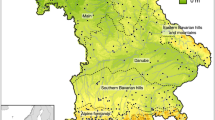Abstract
LABORATORY and field experiments have shown that the Australian plague grasshopper, Austroicetes cruciata Sauss, is well adapted to live in the particular climatic zone where it is found1. An obligate diapause in the egg-stage ensures that the grasshopper produces only one generation each year2. Eggs are laid during November and December (late spring and early summer), but never hatch before the following August or September. Thus the active stages are present during two or three months in the spring when the physical environment is least severe. For the remaining nine months, comprising the hot dry summer and cool wet winter, the insects are in the soil in the egg stage, which is well adapted to resist desiccation during the summer and high humidity during the winter.
This is a preview of subscription content, access via your institution
Access options
Subscribe to this journal
Receive 51 print issues and online access
$199.00 per year
only $3.90 per issue
Buy this article
- Purchase on SpringerLink
- Instant access to full article PDF
Prices may be subject to local taxes which are calculated during checkout
Similar content being viewed by others
References
Andrewartha, H. G., Trans. Roy. Soc. S. Aust., 68, 315 (1944).
Andrewartha, H. G., Bull. Ent. Res., 34, 1 (1943).
Birch, L. C., and Andrewartha, H. G., Bull. Ent. Res., 35, 243 (1944).
Birch, L. C., and Andrewartha, H. G., Aust. J. Exp. Biol. and Med. Sci., 20, 1 (1942).
Birch, L. C., and Andrewartha, H. G., J. Agric. S. Aust., 45, 95 (1941).
Birch, L. C., J. Aust. Inst. Agric. Sci., 11, 189 (1945).
Author information
Authors and Affiliations
Rights and permissions
About this article
Cite this article
ANDREWARTHA, H., BIRCH, L. Measurement of ‘Environmental Resistance' in the Australian Plague Grasshopper. Nature 161, 447–448 (1948). https://doi.org/10.1038/161447a0
Issue date:
DOI: https://doi.org/10.1038/161447a0



